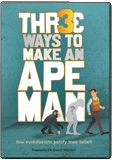Apes Are Smart, Not Creative
Chimpanzees have proven to be quite skillful at learning certain basic tasks—particularly those related to obtaining food—but even evolutionists have to admit that “technological innovation and improvement seem to be uniquely human traits.”
News Source
- New Scientist: “Apes May Imitate but They Struggle to Innovate”
Recent experiments comparing tool-use abilities in apes and humans reveal unsurprising results (at least, to creationists). While many apes have a profound ability for tool use, scientists have found significant limits to their abilities.
One test pitted four-year-old children against multiple varieties of apes (chimps, gorillas, and orangutans) in a challenge to claim a prize. Each subject had to learn to make a loop out of a piece of string, then use the loop to pull on a nail attached to a block. If successful, the apes got access to grapes and the children got stickers. Most of the children who saw the technique demonstrated were able to complete the task with at least some success. None of the apes were successful, however, even after five demonstrations.
Researchers say this and other tests demonstrate the human ability to intentionally repeat a sequence of specific actions, whereas apes are simply “focused on the outcome, rather than the process,” therefore they are limited to only the solutions that they happen to come across. Other scientists point out that humans more readily imitate the exact body motions and actions of tool-use, giving them another advantage as they learn.
Children also seem more willing than apes to alter their problem-solving approaches to try to improve. In one test, chimps were taught how to get honey out of a box by inserting a stick through a hole. While the chimps learned this method easily, they were unable to learn a more advanced method that opened the box up entirely. Human children, on the other hand, had no problem with the second technique. The conclusion researchers came to on this test is especially telling. According to them, the apes simply “didn’t show any kind of cumulative cultural evolution.”
To the evolutionist, this may seem rather perplexing. If man and ape are closely related, then one might expect more adeptness in apes’ problem-solving techniques. Rather, while apes are skilled tool-users, their skills are generally no better than some birds’, dolphins’, and some elephants’ abilities.
As creationists, we know that the anatomical similarities between man and ape are the result not of a common ancestor, but of a common Creator. Furthermore, man was made in God's image (Genesis 1:26–27). The distinctly human ability to innovate is a reflection of God’s own creativity.
Further Reading
For More Information: Get Answers
Remember, if you see a news story that might merit some attention, let us know about it! (Note: if the story originates from the Associated Press, FOX News, MSNBC, the New York Times, or another major national media outlet, we will most likely have already heard about it.) And thanks to all of our readers who have submitted great news tips to us. If you didn’t catch all the latest News to Know, why not take a look to see what you’ve missed?
(Please note that links will take you directly to the source. Answers in Genesis is not responsible for content on the websites to which we refer. For more information, please see our Privacy Policy.)
Recommended Resources

Answers in Genesis is an apologetics ministry, dedicated to helping Christians defend their faith and proclaim the good news of Jesus Christ.
- Customer Service 800.778.3390
- © 2024 Answers in Genesis





